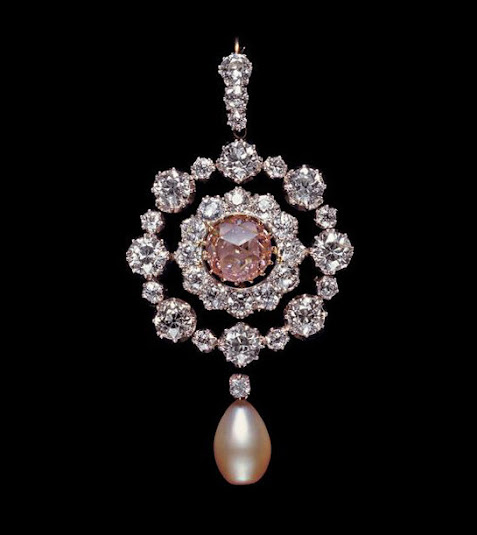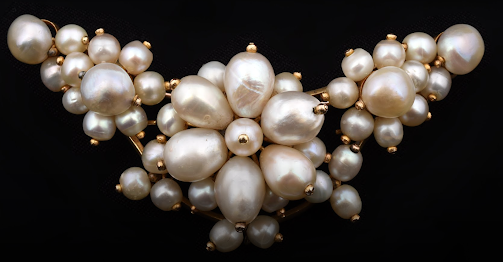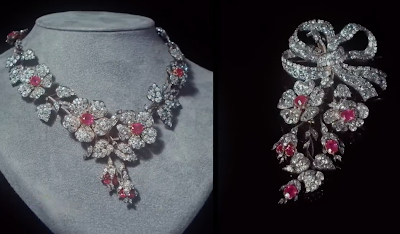 A pearl is formed when an irritant, or parasite gets inside the shell of an oyster, or mollusk. To protect its soft mantle tissue, the mollusk deposits layers of calcium carbonate in the form of the mineral aragonite, which is held together by conchiolin, an organic compound. The mixture is known as nacre or sometimes called mother-of-pearl.
A pearl is formed when an irritant, or parasite gets inside the shell of an oyster, or mollusk. To protect its soft mantle tissue, the mollusk deposits layers of calcium carbonate in the form of the mineral aragonite, which is held together by conchiolin, an organic compound. The mixture is known as nacre or sometimes called mother-of-pearl. To correct a myth: Natural and cultured pearls are both real pearls. Now almost no natural pearls are harvested due to pollution killing off sea life (stopping the production); the dangers of pearl diving; and/or the rise and efficiency of pearl farms.
To correct a myth: Natural and cultured pearls are both real pearls. Now almost no natural pearls are harvested due to pollution killing off sea life (stopping the production); the dangers of pearl diving; and/or the rise and efficiency of pearl farms. The natural pearls sold today are always vintage and therefore pricey because they are scarce and usually inherited.
When natural pearls were the only pearls available only ultra-rich people could afford them, unlike today. Also, oysters were killed to harvest the pearls, whereas today it is in the best interest of pearl farmers to nurture and care for the living mollusk (oysters and mussels). Their livelihoods depend upon it.
 Moreover the composition and beauty between natural and cultured pearls are equal. The main difference is cultured pearls are formed by intention and not an accident of nature. Nowadays when a cultured pearl necklace costs over $150,000, it's because the pearls are large, perfect and uniform -- the result of going through thousands of pearls to find.
Moreover the composition and beauty between natural and cultured pearls are equal. The main difference is cultured pearls are formed by intention and not an accident of nature. Nowadays when a cultured pearl necklace costs over $150,000, it's because the pearls are large, perfect and uniform -- the result of going through thousands of pearls to find.1) Akoya pearls are grown in Japan and China. They are usually
white or cream in color and round in shape. They tend to be smaller compared to the pearls grown in other regions, ranging from 2mm (tiny) to 10mm (rare) in size.
2) South Sea pearls come from Australia, Indonesia and the Philippines. They are white, cream or golden in color and are the largest in size of all pearls, ranging from 9mm to 20mm.
3) Tahitian pearls are produced in Tahiti, as well as, the French Polynesian Islands. These are the black cultured pearls you see, yet their colors can include grey, blue, green and purple. Typical sizes range from 8mm - 16mm.
 |
$300,000+ undyed cultured pearls at Saks 5th Avenue. I love the research I must do to write these blogs!😍 |
When buying pearls, there are 5 characteristics to consider:
1) Luster - gives pearls their beauty.
 2) Surface (complexion) - includes smoothness and the lack of blemishes. As an article of nature, however, sometimes blemishes add to a pearl's uniqueness and cost.
2) Surface (complexion) - includes smoothness and the lack of blemishes. As an article of nature, however, sometimes blemishes add to a pearl's uniqueness and cost. 3) Size - The value of pearls rises starting at 8mm. Over 15mm is very rare and expensive. Fortunately, when I bought pearl earrings, the 7mm size looked more proportional and stylish in my ears than the bigger sizes. So bigger, more expensive isn't always better. Try on different sizes to know what size looks best. Like furniture needs space to create balance in a room, sometimes you need ear to surround and showcase pearl earrings!
3) Size - The value of pearls rises starting at 8mm. Over 15mm is very rare and expensive. Fortunately, when I bought pearl earrings, the 7mm size looked more proportional and stylish in my ears than the bigger sizes. So bigger, more expensive isn't always better. Try on different sizes to know what size looks best. Like furniture needs space to create balance in a room, sometimes you need ear to surround and showcase pearl earrings!4) Shape - There are 8: round, semi-round, oval, drop, baroque, button, pear and circle. Shape is subject to personal taste. Perfectly round pearls are the rarest and take a bit of effort to match, so have an edge in value.
5) Color - There are many hues including white, cream, pink, silver, gold, blue, purple and black. Color is determined by the lip of the living oyster or mussel. Different mollusks produce different colors and sizes.
Although only registering a 4.5 (out of 10) on the Moh's Scale of Hardness, if you take care of pearls they will last several lifetimes. Clean them sometimes (your skin oil and perfume dissolve them); and store them in a soft cloth, or pouch to avoid scratches from other jewelry.
Pearl rings were the first pieces of jewelry my parents give me; and over time a pearl ring, earrings and necklace were the first pieces of jewelry I bought for myself after I began working to look like a grownup at fancy shindigs.
Pearls are beautiful, timeless and budget-friendly. Most of us can afford a lovely set (earrings, ring and necklace) of freshwater pearls without mortgaging our house. Do you own pearls?⚪⚪⚪
You may also enjoy:
In My Jewelry Box
Tanzanite At Tiffany's
Fancy Shaped Diamonds
Which Diamond "C" Is The Most Important?


















































